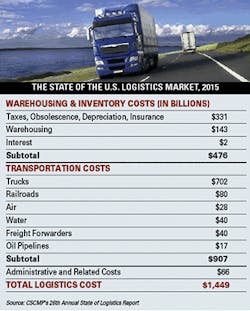Logistics: The Economy's Best Kept Secret
To paraphrase Julius Caesar, the state of logistics can be divided into three parts: worsening capacity constraints, a growing shortage of talent, and a pressing need for sophisticated technological solutions. All three are inextricably interrelated, and all are intensifying with each passing day.
The bad news is that the first two are getting worse, while market acceptance of technological solutions may be too slow to save some companies from looming obsolescence. The good news for third-party logistics providers is that these trends are driving more companies to turn to 3PLs for answers.
Although economic signals were mixed earlier this year, most projections point to continued growth at least through the end of the year and into early 2016. When it comes to later next year, some leading indicators point to possible softening, including faltering truck tonnage growth and some chemical industry trends. Consumer spending remains strong but has proven weaker than expected in the wake of falling fuel prices.
In 2014 revenues for 3PLs shot up by 7.4% to a total $157.2 billion, exceeding the year's 2.8% growth in overall logistics spending, according to the annual State of the Logistics Report published by the Council of Supply Chain Management Professionals and sponsored by Penske Logistics.
"More companies are outsourcing logistics than we've seen in many years," says Joe Carlier, senior vice president of sales at Penske Logistics. Carlier spoke recently as part of a panel discussion of top shipper and provider executives at a State of Logistics press conference in Washington, D.C., in June.
"As business has increased, customers are saying they need to increase their warehousing as they build up their inventories," he adds. "But rather than build for themselves, they're looking to third-party providers. Rather than go through the challenge of hiring drivers, they're outsourcing."
Total U.S. business logistics costs rose to $1.45 trillion in 2014, a 3.1% increase from the previous year, CSCMP reports. This was lower than the U.S. gross domestic product, resulting in a slight decline in logistics as a percent of GDP from 8.4% to 8.3%.
Although it would be nice to chalk this up to improving supply chain efficiencies, it resulted almost entirely from the Federal Reserve keeping interest rates low, says CSCMP report author Rosalyn Wilson.
Other components of carrying costs—taxes, depreciation, insurance and obsolescence—were up 1.2% due to inventory growth.
Wilson, who is senior business analyst for Parsons Corp., also says that because of the downward pressure on interest rates, the 8.3% logistics cost ratio should not really by viewed as a good thing, and that an overall logistics cost ratio of 9.5-10% would be more indicative of a healthy economy.
Inventories Are Not Sitting
Wilson also reports that inventory carrying costs grew only 2.1% in 2014 to $2.47 trillion, and inventories grew in the wholesale and retail categories, while manufacturing inventories were down.
The warehousing industry had a good year in 2014, and warehousing costs rose 2.4%. Anecdotal evidence from this July suggests that while inventories are increasing, so is throughput, with many shipments spending as little as one day in storage before moving to their next destination.
According to some warehouse operators, not all of this stems from e-commerce and pressure flowing backward from the growth in same-day deliveries. It seems the entire supply chain seems to be speeding up.
As we noted last year, capacity issues are only getting worse, and that's not just confined to warehousing and trucking. The West Coast ports labor dispute may be over, but infrastructure limitations and a shortage of chassis equipment at ports on both coasts are causing additional problems. Various attempts to manage the chassis pool have proven largely unsuccessful thus far.
A capacity crunch on the nation's railroads poses another threat. In spite of all the capital investment the Class 1 railroads are making in infrastructure, some shippers say they are seeing the beginnings of another capacity crisis similar to the one in 2013-14 that left mountains of grain and other crops like soy beans rotting in piles on the ground because not enough railcars were available.
For all of the railroads' public statements—including an expensive TV advertising campaign—talking about how much money they are spending on system improvements, transportation analyst firm FTR Associates reports that total carloads were down about 335,000 from the second quarter through June 27 this year.
Although the biggest single factor in this decline can be chalked up to the drop in coal shipments due to restrictions on coal-fired power plants, other industry sectors have suffered as well, although intermodal rail shipments continue to show strength since rising 10.6% in 2014, as do shipments of oil and gas.
Rail shippers also are finding that they have to pay for their pain. The persisting deterioration in service has resulted in skyrocketing demurrage bills, which railroads refuse to negotiate down. While average train speeds during the first half of this year improved 3.1% compared to 2014, they are still down 6.9% from what they had been in 2013, according to FTR.
The Talent Drought
Another issue logistics and transportation providers struggle with is the evaporating pool of available talent, ranging from truck drivers and warehouse workers to the ranks of IT personnel and management.
According to the most recent U.S. Bureau of Labor Statistics report in July, the number of job openings in April at transportation, warehousing and utility companies soared 70.3% year over year in April to the highest point in a decade. However, BLS says warehousing succeeded in adding only 9,600 jobs in May.
This has been especially problematic in the for-hire trucking industry, which added 7,400 jobs on a seasonally-adjusted basis in June, driving the industry's employment total to a new all-time high and past the previous record set in January 2007.
But that doesn't mean that it has managed to hire enough drivers; far from it. American Trucking Associations estimates that the current shortage of drivers is roughly 35,000 to 40,000, and says fleets will need to recruit at least 100,000 new drivers a year over the next decade to keep pace with demand.
One tool ATA is using to address the issue is a recruitment program for military veterans that has enjoyed success—and not just in hiring drivers but sales and management positions as well. In addition, many fleets have reacted to the driver shortage by boosting pay and reaching out to recruit more women and minorities.
ATA also wants driver qualification rules changed to make it easier for younger drivers to join the profession. However, even if this effort succeeds, recruiting younger drivers will remain problematic. To be blunt: Very few young people want to become truck drivers. It has gotten to be a cliché at many industry meetings that if you ask an audience of logistics executives to raise their hands if they would want their son or daughter to become a truck driver, not a single hand goes up.
Many veteran drivers are leaving the industry because of the continual layering of new regulations, and the intensifying assault on independent contractor status by policymakers and regulators at both the federal and state levels.
Another factor is seldom given the weight it deserves: the ever worsening traffic congestion throughout the country. The erosion of driver morale stemming from having to drive on the congested arteries of our major metropolitan areas should not be discounted.
An experienced professional driver told me he is leaving his job in the logistics division of one of the nation's largest truckload companies because for the first time in his life he developed migraine headaches due to the long hours and worsening conditions created by the terrible traffic in his area.
However, truck drivers are just the most visible component of the talent drought. Wilson points out, and warehouse operators confirm, that warehousing also suffers from a labor shortage similar to that in trucking.
"While demand for logistics is increasing, the industry faces a talent shortage and needs more logistics engineers, technology professionals, warehouse workers and truck drivers to meet the needs of current and evolving freight fulfillment models businesses and consumers rely on for their goods and services," observes Marc Althen, president of Penske Logistics.
Agreeing with him is Mary Long, vice president of logistics and network planning for Domino's Pizza, a member of the panel that discussed the State of Logistics report at the CSCMP press conference. "It's not just about drivers; it's about finding talent at all levels across the logistics function, from drivers to directors," she said.
Fellow panel member Ron Marotta, vice president of the international division of the ocean shipping company Yusen Logistics (Americas), sees the same phenomenon at work. He believes attracting young talent has become the industry's greatest challenge. "It's more difficult than it has been," he says, adding that companies need to invest more in young talent "to keep them, to keep them learning, to keep them going."
The industry is seeking answers in training those within its own ranks to move up, as well as reaching outside the industry to students at the college, high school and even elementary school levels. Among the industry organizations pursuing such programs are CSCMP, Warehouse Education and Research Council (WERC) and MHI.
Technology Solutions: Beyond Drones
The driver shortage in particular has fueled the healthy growth in 3PL business as companies turn to both asset-based and non-asset-based 3PL providers for transportation solutions, including dedicated contract carriage and outsourced transportation management.
In 2014 the growth of domestic transportation management services soared 20.5% while dedicated contract carriage jumped by 10.4%, according to the CSCMP report.
Another trend is for shippers to seek transportation management solutions by forging closer relationships with their for-hire carriers along with seeking DCC arrangements, Penske's Carlier observes. "We're seeing hybrid solutions in which shippers are using dedicated contract carriage and developing closer relationships with carriers." He notes that Penske Logistics has seen an increase of about 20% in customers seeking this solution.
Using drones for package delivery and driverless trucks may still be years away, but using drones to track containers and rolling stock in large yards is already a reality. Dean Wise, vice president of network strategy for BNSF Railway and CSCMP panel member, says his company has deployed drones to help with train safety inspections.
Public wariness concerning driverless trucks may delay their widespread use for another decade, but today's sophisticated computer controls and communications technology on trucks mean that "truck trains" may not be far off.
Robotics in the warehouse may be nothing new, but they are gaining in popularity both because of their speed and reduced error rate and as an answer to the warehouse labor shortage. One glance at the list of exhibitors at recent trade shows and meetings shows this growth.
The same is true of software providers. The day when warehouse operators could get by with Windows 95 and do their accounting on Excel spreadsheets is long gone.
With more companies in the retail supply chain resorting to Big Data analyses to sharpen their forecasting abilities, they expect 3PL warehouses to be capable of faster and more efficient inventory turns and to use the data to maximize the cube on trucks.
Just how important high-tech solutions are for retail firms was made brutally clear by consultant Jim Tompkins of Tompkins International (and a member of the MH&L Editorial Advisory Board), when he spoke at the recent eyefortransport Logistics Forum in Chicago. Both business-to-business and business-to-consumer e-commerce and omni-channel capabilities are no longer just a market differentiator and a way to expand sales, but an absolute necessity if those companies expect to survive, he says.
Tompkins held up a magazine article with the headline: "U.S. Retail Is Slowly Dying." That is totally false, he declared. "There is nothing slow about it."
He even went so far as to characterize differentiating e-commerce into the B2C and B2B categories as "stupid terms." The reality, Tompkins says, is that "everybody is sourcing everywhere to sell everywhere."
As a result, omni-channel is the only way to go, and retailers and their suppliers need a lot of help from 3PLs in this area, he observes. "There are a lot of companies doing omni-channel but it's not clear that they know what they are doing." For example, Tompkins notes, "If you are operating distribution centers but not doing fulfillment, you're toast. The goal is to create a seamless experience for the customer."
In the end the question is: Will you be the one to provide solutions to challenges of capacity, talent and technology, or end up their victim?
David Sparkman is founding editor of ACWI Advance (www.acwi.org), the newsletter of the American Chain of Warehouses Inc., as well as a member of the MH&L Editorial Advisory Board.
About the Author

David Sparkman
founding editor
David Sparkman is founding editor of ACWI Advance (www.acwi.org), the newsletter of the American Chain of Warehouses Inc. He also heads David Sparkman Consulting, a Washington D.C. area public relations and communications firm. Prior to these he was director of industry relations for the International Warehouse Logistics Association. Sparkman has also been a freelance writer, specializing in logistics and freight transportation. He has served as vice president of communications for the American Moving and Storage Association, director of communications for the National Private Truck Council, and for two decades with American Trucking Associations on its weekly newspaper, Transport Topics.




